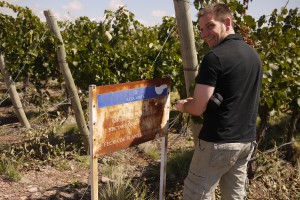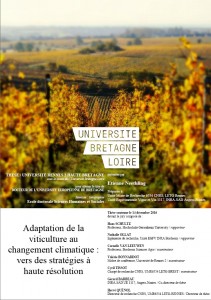Adaptation of cultural practices to climate change
Objectives
Action B1 aims to develop adaptation strategies at the vineyard scale, reproducible in other areas of Europe, and simulate the impact of climate variability on vine dynamics and viticultural strategies.
The objectives are as follows:
- to develop a systemic and integrated modelling environment, capable of simulating grapevine growth and berry ripening under different conditions and constraints (slope, aspect, soil type, climate variability …) and integrating production strategies and corresponding adaptation rules according to the evolution of these constraints,
- then construct specific viticultural models for each demonstration site.
A generic model (for a site-specific viticultural activity) will be developed, to reproduce the impact of the spatial and temporal variability of climatic conditions on grapevine growth and berry maturity using an approach that combines technologies derived from greenhouse gas (GHG), agent-based models and spatial and temporal databases. We will then use the model to identify adaptation rules, according to the evolution of environmental constraints, with particular focus on high-resolution climate changes. The adaptation strategies will be monitored, assessed and redefined in response to the activities in the demonstration sites
Action leader

Cyril Tissot
Deliverable
Adaptation of cultural practices to climate change: high resolution strategies
Etienne Neethling (INRA-ANGERS)
Adaptation to climate change is a major challenge facing the viticulture sector. Within an appropriate temporal and spatial framework, the aim of this thesis was to enhance the conception of climate change adaptation in viticulture, all towards constructing high resolution strategies. The methodological framework used in this study consisted of several steps. Using a regional climate model, the first step was to evaluate the potential impacts of future climate changes on grape growing in the Anjou-Saumur wine growing sub-region. With warming predicted to continue by +1.1°C to +3.8°C in the far future, grapevine phenology is expected to advance significantly. Secondly, two contrasting study areas in Anjou-Saumur were equipped with climatic and agronomic measurements at vineyard-level scales. For three consecutive growing seasons, local variability in climate- and grapevine-related variables were studied. Results have shown a strong spatial variability in local climate conditions, which were reflected on grape phenology and grape composition. This spatial heterogeneity in local conditions should represent an important buffer in response to future climate changes, allowing winegrowers to manage the expected climate change impacts. And finally, wine growers’ perceptions, vulnerability and adaptive processes to climate variability and change were assessed through individual semi-structured interviews. Within the context of climate change and the key issues surrounding adaptation, this thesis have highlighted the importance of local environmental knowledge and contextual understanding in framing adaptation strategies across different temporal and spatial scales.





